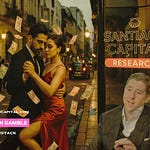“If you analyze the United States in isolation, the only logical conclusion is that it’s a disaster waiting to happen.” – Brent Johnson
If there were a betting market for economic collapse, the U.S. dollar would’ve been declared dead years ago. And yet, here it stands—hated, doubted, cursed… and rising.
We’ve all heard the arguments. The debt is too big. Interest rates are too high. China’s dumping Treasuries. The Fed is broke. And yet, the dollar persists, like a cockroach in a world of economic flamethrowers.
Is the U.S. dollar doomed? Or is it about to boom before it busts?
To answer that, we have to step back—way back—and stop thinking like Americans. Because this isn’t a story about America in a vacuum. It’s about everyone else, too. And that’s where things get interesting.
Brent Johnson didn’t invent doom. But like many of us, he wore the uniform for years.
It started in 2006 when a book—Empire of Debt by Bill Bonner—cracked his worldview wide open.
Bonner was sharp. Sarcastic. Subversive. And deadly accurate in warning about U.S. overindulgence. That book set Brent on a path. He started analyzing the U.S. like a company: bloated, debt-ridden, badly managed. A disaster in slow motion.
Then 2008 hit, and he thought, “This is it.” Doom was here. He was ready.
Except it wasn’t.
From 2010 to 2014, something strange happened. The dollar didn’t collapse. It soared.
How could a system so obviously broken—so mathematically unsustainable—produce the world’s strongest currency?
That contradiction drove him nuts. So he did something unusual: he stopped looking at America and started looking at the world.
The Sunday Morning Revelation
One lonely Sunday, Brent sat in a conference room surrounded by stacks of labeled papers: “United States,” “Europe,” “Japan,” “China,” “Banks.” He was trying to map the global financial system by hand.
And it hit him—he was still thinking like Brent Johnson. Like an American.
He hadn’t truly stepped into the shoes of other players. He was looking at them, not through them.
When he finally did, the picture changed. The U.S. wasn’t a disaster in isolation. It was a disaster in a global neighborhood full of even bigger disasters.
That’s when the Dollar Milkshake Theory was born.
A Quick Shot of Milkshake
The idea is simple.
In a world where every central bank printed money to survive, the U.S. had the deepest, most liquid financial markets. So as global liquidity surged, capital flowed uphill—to the U.S.—like a thick, sugary milkshake.
Why?
Because everybody needs dollars. The global financial plumbing runs on them. Over $13 trillion in dollar-denominated debt exists outside the United States, and that doesn’t count derivatives or off-balance-sheet madness.
And the real kicker?
Only the U.S. can print them.
When crisis hits, the scramble isn’t for yuan, yen, or euros. It’s for dollars. The system feeds on them, and when the supply tightens, the straw slurps from everywhere else.
The dollar rises. Everything else breaks.
Debt? Sure. But Relative to What?
Let’s be clear—the U.S. has problems. Big ones.
The debt is over $36 trillion and growing like a weed.
Nearly a third of that matures in the next two years and will need to be refinanced at higher interest rates. Interest expense has overtaken defense spending. Foreign buyers are letting Treasuries roll off instead of re-upping.
None of that is great.
But the problem with using that as a death sentence is simple: everybody else is worse.
Europe? Aging, energy-dependent, and stuck in a fiscal straitjacket.
Japan? A demographic time bomb with the highest debt-to-GDP ratio in the developed world.
China? Slowing growth, overbuilt, and short on trust.
Emerging markets? Tethered to a dollar they can’t print and barely earn.
It’s like a marathon where everyone has a broken leg. The U.S. just limps better.
The Myth of Foreign Diversification
You’ll hear that the world is de-dollarizing. That foreign central banks are selling Treasuries. And they are—to a degree.
China’s holdings have dropped. Japan’s too. Central banks are buying gold. Sovereign wealth funds are moving into other assets.
But here's the rub: when things hit the fan, nobody sells Treasuries. They buy them.
We’re just getting to the good part.
When the storm hits, where does the world actually run—and why does it keep choosing the dollar?
Let’s follow the trail through crisis, contradiction, and central bank desperation…
In March 2020, during the COVID panic, the dollar surged and Treasuries were the only liquid market that functioned.
Why? Because no matter how much you dislike Uncle Sam, when the storm hits, you run for the only safe harbor you trust.
And that harbor is still the U.S. Treasury market.
The Fed’s Broken Balance Sheet
Now, the Fed. Ah yes, the central bank that printed trillions at zero and now holds assets yielding less than current market rates. On paper, it’s insolvent. If it were a regular bank, it would be shuttered.
But it’s not. It’s the Federal Reserve. It can create base money with a keystroke.
Other central banks don’t have that luxury. They hold Treasuries as reserves. If Treasuries crater, they suffer. Not just the U.S.
Which brings us to a critical point Brent often makes: the U.S. doesn’t hold foreign debt, but everyone else holds U.S. debt. That asymmetry matters.
A Game of Match Play
Think of it this way: the global economy isn’t golf stroke play. It’s match play. You don’t need the best score. You just need to beat the other guy on each hole.
And the U.S., for all its flaws, beats most.
Largest consumer market? Check.
Deepest capital markets? Check.
Global reserve currency? Check.
Most powerful military? Check.
Most gold? Check.
Energy and food independence? Check and check.
Even if the dollar stumbles, it’ll fall forward while everyone else falls backward.
What Happens If the Dollar Actually Crashes?
Let’s play that out.
If the dollar truly collapsed—say, due to a loss of confidence or a coordinated dump of Treasuries—what happens?
Well, for starters, foreign central banks would vaporize. Their balance sheets depend on U.S. assets. A crash in Treasuries hits them harder than it hits the U.S. itself.
Global trade would freeze. Credit markets would seize. Panic would ripple through every country that relies on dollars—which is to say, all of them.
There is no escape hatch. No magical replacement currency. Not the yuan. Not the euro. Not even gold—at least not without first getting dollars to buy it.
So if you're going to bet against the dollar, make sure you’ve also got a plan for what happens when everything else breaks first.
The Real Endgame
Brent doesn’t pretend the U.S. is invincible. There will be a reckoning. You can’t run fiscal deficits forever. You can’t pay $1.2 trillion a year in interest without consequence.
The point isn’t that the U.S. is immune. It’s that the U.S. will likely be the last to fall, not the first.
In the meantime, the dollar might boom. Painfully. Violently. In a way that squeezes every debtor around the world—and forces the Fed’s hand once again.
The Cliffhanger
So what’s next?
Will the Fed cut rates and reflate the bubble one more time? Will the world push harder toward de-dollarization? Will a new crisis push global capital right back into the milkshake?
Time will tell. But for now, Brent’s view is clear:
This isn’t a solo sport. It’s a brutal, chaotic, multi-player game. And the U.S. dollar, flawed as it is, remains the least dirty shirt in the laundry basket.
Boom before bust. Not because we’re strong—but because everyone else is weak.
The game continues.
If you want to understand where things might go from here, Brent’s full body of work lives at MacroAlchemist.com and SantiagoCapital.Substack.com. He’s not selling hopium—just perspective.
And these days, that’s worth its weight in milkshake.
🔴 Haven’t read Brent’s latest premium report for industry professionals?












